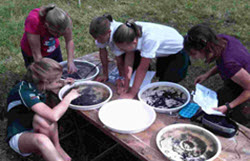The Truth About Tap
It’s important to note that the federal government does not require bottled water to be safer than tap. In fact, just the opposite is true in many cases. Tap water in most big cities must be disinfected, filtered to remove pathogens, and tested for cryptosporidium and giardia viruses. Bottled water does not have to be.
Both kinds of water are tested regularly for bacteria and most synthetic organic chemicals, but city tap is typically assessed much more frequently. For example, bottled-water plants must test for coliform bacteria just once a week; city tap needs to be tested 100 or more times a month.
Limits on chemical pollution for both categories are almost identical. The one place where bottled water might have the edge is in the case of lead; because many older homes have lead pipes, the EPA standard for tap water is less strict—one-third of the FDA’s standard for lead in bottled water.

Regardless of your water source, here are two situations that may require testing:
Do you suspect lead may be in some of your household plumbing materials and water service lines?
Most water systems test for lead as a regular part of water monitoring. These tests give a system-wide picture, but do not refl ect conditions at a specifi c household faucet. If you want to know if your home’s drinking water contains unsafe levels of lead, have your water tested. Testing is the only way to confi rm if lead is present or absent. Some faucet and pitcher fi lters can remove lead from drinking water. If you use a fi lter to remove lead, be sure you get one that is certifi ed to remove lead by NSF International.
Are you considering a home water treatment unit?
Find out what is in your water and what you might want to remove before contacting potential dealers. Be informed so you can make the right decisions

Research Specific Contaminants
Once you have your water quality data, you can go a step further and look up each chemical of concern in EWG’s chemical database or in the EPA’s list of water contaminants. The Water Quality Association (a business association for the water treatment industry) has interesting information on emerging contaminants, but don’t get too worked up—the association represents companies that make money from water testing, so it has a vested interest in making you anxious.

How Much Water Do You Need?
Your body weight is more than 50% water. Without water, you couldn’t maintain a normal body temperature, lubricate your joints, or get rid of waste through urination, sweat, and bowel movements.
Not getting enough water can lead to dehydration, which can cause muscle weakness and cramping, a lack of coordination, and an increased risk of heat exhaustion and heat stroke. In fact, water is so important that a person couldn’t last more than five days without it.
So how much water do you need? Enough to replace what you lose daily through urination, sweating, even exhaling. And your need for water increases:
- In warm or hot weather
- With vigorous physical activity, such as exercise or working in the yard
- During bouts of illness, especially if you have a fever, are vomiting, having diarrhea or coughing
You often hear that you need to drink eight 8-ounce glasses of water each day. The Institute of Medicine’s Food and Nutrition Board recommend that women drink more than 11 8-ounce glasses (91 ounces) of water daily, and men drink more than 15 glasses of water(125 ounces) per day.
Biological Indicators
Biological monitoring metrics is the simplest and least expensive method. It involves monitoring the presence and abundance of members of bio-indicators common to the area, eg:
- Insects such as the mayfly, stone-fly and caddisfly. Generally, the greater the number found, the better the water quality. Organisations in the United States, such as EPA offer guidance on developing a monitoring program and identifying members of these and other aquatic insect orders.
- Bivalve molluscs are largely used as bio-indicators to monitor the health of aquatic environments in both fresh water and the marine environments. A typical project is the Mussel Watch Programme, but today they are used worldwide.
- Benthic macro-invertebrates (such as the aquatic earthworm) is a bio-monitoring tool that is used by the Southern African Scoring System (SASS) system to measure river health. miniSASS is a simpler scoring system that can be used by anyone, even school children.